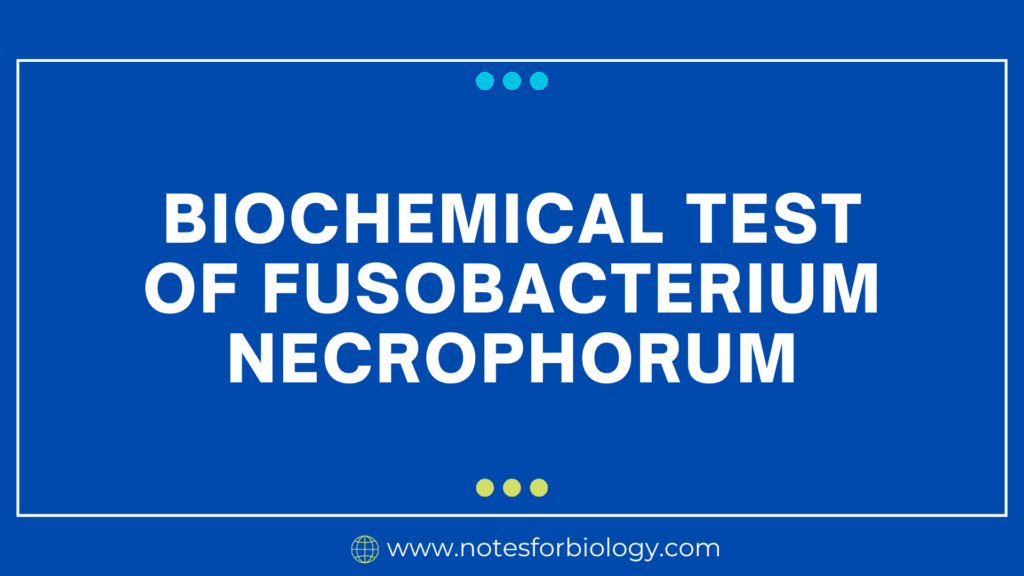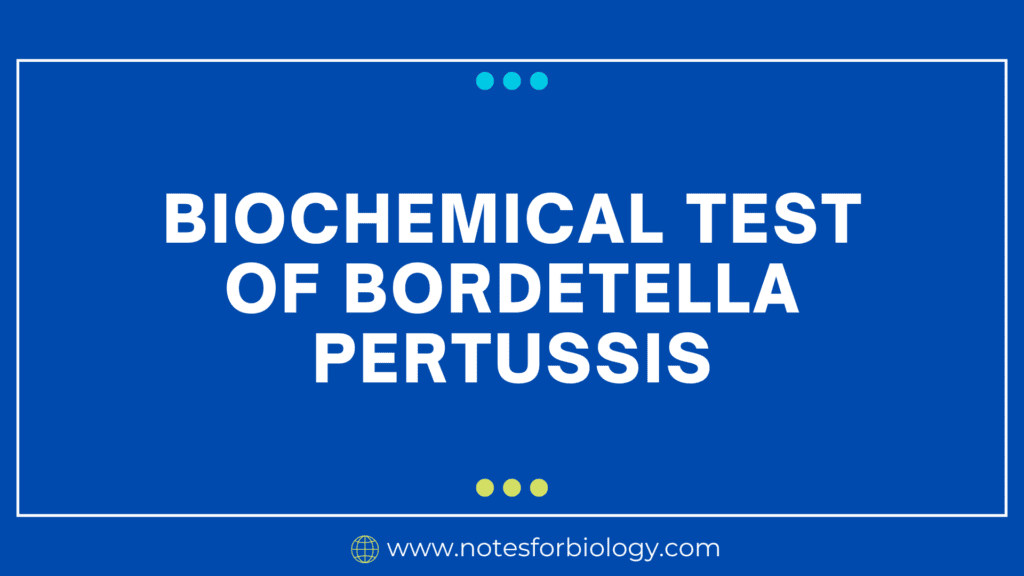Fusobacterium necrophorum is a Gram-negative, obligatory anaerobic bacterium that is frequently linked to serious infections in humans and animals. It can result in liver abscesses and other necrotic infections. Biochemical tests are used for identification, which helps with accurate diagnosis and treatment by revealing the unique characteristics of the object.
Table of Contents
Definition

Fusobacterium necrophorum is a Gram-negative anaerobic bacterium that is commonly associated with various infections in animals and humans. It is known to cause Lemierre’s syndrome, liver abscesses, and other necrotic infections.
The biochemical tests used to identify Fusobacterium necrophorum typically include the following:
1. Gram Stain
Fusobacterium necrophorum shows up under a microscope as long, slender rods with tapered ends when stained with a Gram stain, indicating a Gram-negative result. The cells frequently exhibit pleomorphism, which denotes a range of sizes and shapes. Fusobacterium necrophorum’s unique Gram stain property is essential for separating it from other bacteria and aiding in its identification.
2. Anaerobic Growth
The obligate anaerobic growth that Fusobacterium necrophorum demonstrates enables it to only survive in oxygen-free settings. It takes particular anaerobic conditions to cultivate this bacteria, which cannot grow in the presence of oxygen. Because it emphasizes the necessity of specific anaerobic culturing techniques for the efficient isolation and research of Fusobacterium necrophorum, this growth characteristic is critical for its identification and separation from other bacteria.
3. Catalase Test
When Fusobacterium necrophorum is tested for catalase, the results are negative, meaning that the catalase enzyme is not present. A culture of this bacteria does not generate bubbles when hydrogen peroxide is added, indicating that catalase activity is absent. One important biochemical feature that helps differentiate Fusobacterium necrophorum from other bacterial species that generate the catalase enzyme is the negative catalase test result.
4. Oxidase Test
The negative result of the oxidase test indicates an inability to detect the presence of the cytochrome c oxidase enzyme. A lack of color change when the oxidase reagent is added to a culture suggests no oxidase activity. This negative test is significant for distinguishing it from other bacteria that exhibit positive oxidase activity, serving as a crucial biochemical marker.
5. Indole Test
Usually, the tryptophanase enzyme is present when the indole test for Fusobacterium necrophorum produces a positive result. The formation of indole is confirmed when a red hue appears when this bacteria is cultivated in a tryptophan-containing medium and Kovac’s reagent is added. The biochemical feature of the positive indole test helps identify it and sets it apart from other bacteria that could provide negative indole test findings.
6. Nitrate Reduction Test
A good result from the nitrate reduction test in Fusobacterium necrophorum frequently indicates that the bacterium can convert nitrate to nitrite or other reduced chemicals. A crimson hue appears when it is grown in a nitrate-containing medium and the proper reagents are added, indicating nitrate reduction. Zinc powder can be added to further confirm nitrate reduction in situations where the initial reaction is inconclusive.
7. Lipase Test
The presence of the lipase enzyme is often indicated by a positive lipase test result for Fusobacterium necrophorum. When this bacterium is grown on a lipid-containing media, like egg yolk agar, turbidity clears up or a halo forms around the colonies, both of which are signs of lipase activity. This lipase test positive is a crucial biochemical trait that helps identify it and sets it apart from other bacteria that might not have this enzyme activity.
8. Esculin Hydrolysis
Variable outcomes can arise from esculin hydrolysis in Fusobacterium necrophorum. Certain strains of the bacteria have the ability to hydrolyze esculin, which causes the medium to darken because esculetin and glucose are formed. But this ability isn’t always present in all strains of Fusobacterium necrophorum. This means that even while esculin hydrolysis is visible in certain isolates, it might not be a valid test for all Fusobacterium necrophorum strains. To correctly identify this bacteria, additional biochemical tests need be used in tandem with this one.
9. Gelatin Hydrolysis
In Fusobacterium necrophorum, the gelatin hydrolysis test usually produces a positive result, confirming the presence of the gelatinase enzyme. This bacteria can liquefy the medium by liquefying the gelatin by enzymatic degradation when it is cultivated on a gelatin-containing medium. It can be identified from other bacteria that might not have this enzymatic activity thanks to a crucial biochemical trait: a positive gelatin hydrolysis test.
10. Lecithinase Test
Fusobacterium necrophorum lecithinase tests usually produce positive results, suggesting the existence of the enzyme. Because lecithin is hydrolyzed by enzymes when this bacterium is grown on a lecithin-containing medium, like egg yolk agar, opacity or precipitation zones form surrounding the colonies. A useful biochemical trait that helps identify it and sets it apart from other bacteria that might not have this enzymatic activity is a positive lecithinase test result.
11. Sugar Fermentation Tests
Fusobacterium necrophorum can be recognized by its characteristic sugar fermentation patterns. It often ferments glucose when grown in medium containing various sugars, such as glucose, lactose, and sucrose. This process produces acid without generating gas. It may be accurately identified in clinical and laboratory settings thanks to these sugar fermentation patterns, which are significant biochemical features that set it apart from other bacteria.
12. Phenylalanine Deaminase Test
Fusobacterium necrophorum frequently produces a negative result when the phenylalanine deaminase enzyme is tested, suggesting that the enzyme is absent. In the absence of phenylalanine deaminase activity, this bacteria usually does not generate a green color when cultivated in a phenylalanine-containing medium with ferric chloride added. The ability of Fusobacterium necrophorum to produce the enzyme phenylalanine deaminase in its negative form is a crucial biochemical trait that helps identify the bacteria and sets it apart from other viable candidates.
Clinical Relevance
In both human and veterinary medicine, it is an important pathogen. Lemierre’s syndrome, a serious illness characterized by septic thrombophlebitis of the internal jugular vein, is most prominently linked to it in humans. Appropriate therapy, which frequently entails antibiotics effective against anaerobic bacteria, depends on accurate identification by biochemical testing.
Culture Characteristics
- Growth on Blood Agar: After a protracted incubation period, the tiny, translucent colonies may take on the distinctive “fried egg” appearance.
- Hemolysis: On blood agar, there may be mild hemolysis.
Antibiotic Sensitivity
Most commonly, Fusobacterium necrophorum is susceptible to:
- Beta-lactam antibiotics (including derivatives of penicillin)
- Metronidazole
- Clindamycin
Antibiotic susceptibility testing is advised for accurate treatment planning because resistance patterns can differ.
In order to properly diagnose and treat the infections that Fusobacterium necrophorum produces, it is helpful to have an accurate grasp of the biochemical traits and tests that describe the bacteria.
Frequently Asked Question(FAQ)
What are the common biochemical tests used for identifying Fusobacterium necrophorum?
Common biochemical tests include the esculin hydrolysis, gelatin hydrolysis, lecithinase test, sugar fermentation tests, phenylalanine deaminase test, lipase test, nitrate reduction test, indole test, catalase test, oxidase test, and sugar staining.
Why is the catalase test performed in the identification of Fusobacterium necrophorum?
The catalase test helps differentiate Fusobacterium necrophorum from catalase-positive bacteria. Fusobacterium necrophorum typically yields a negative catalase test result.
Related Articles




